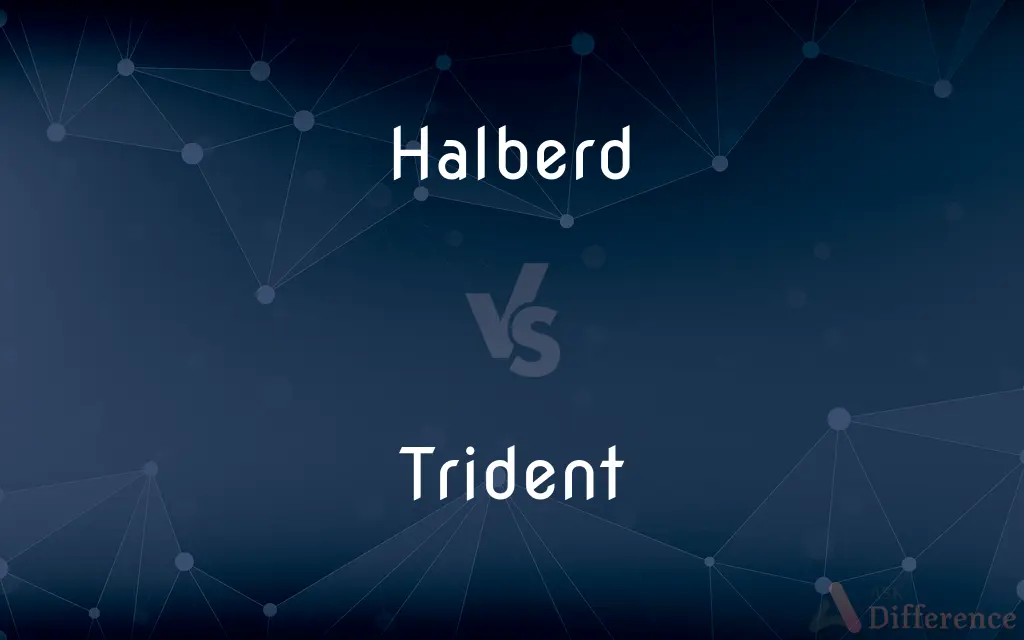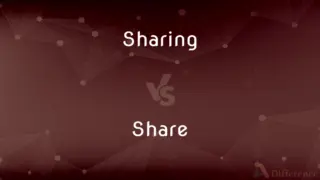Halberd vs. Trident — What's the Difference?
By Fiza Rafique & Urooj Arif — Updated on April 30, 2024
A halberd is a pole weapon combining an axe, hook, and spike, used in medieval warfare, while a trident is a three-pronged spear, historically used for fishing and as a weapon in ancient times.

Difference Between Halberd and Trident
Table of Contents
ADVERTISEMENT
Key Differences
Halberd combines multiple functions in one weapon, effective in hooking, slashing, and thrusting against opponents, particularly useful in medieval European battles. Whereas, trident, traditionally a tool for fishermen, also served as a piercing weapon in ancient cultures, particularly in gladiatorial combat.
Halberd is characterized by its large axe-like blade, a rear hook or fluke, and a spear point at the tip, making it versatile in both offensive and defensive combat. On the other hand, trident features three sharp points, which could trap enemy weapons or deliver multiple puncture wounds.
Halberd was a key weapon for infantrymen to combat opponents both on foot and horseback, effectively reaching around shields and pulling riders from their mounts. While, trident was less common in large-scale warfare, often associated more with individual combat or ceremonial roles.
Halberd saw widespread use across Europe from the 14th to the 17th century, adapting to the evolving armor technologies. Conversely, trident has remained more static in design, maintaining its symbolism and utility primarily in maritime contexts.
In popular culture, halberd is often depicted in medieval settings or fantasy genres as a weapon of knights or guards. Whereas, trident is iconic in mythological representations, famously wielded by figures like the Roman god Neptune or the Greek god Poseidon.
ADVERTISEMENT
Comparison Chart
Design
Axe blade, hook, and spike
Three-pronged spear
Historical Use
Medieval European warfare
Ancient fishing and gladiatorial combat
Combat Role
Offensive and defensive, anti-cavalry
Mainly offensive, ceremonial
Symbolism
Military strength, versatility
Sea power, authority, mythology
Cultural Representation
Medieval warriors, fantasy settings
Mythological deities, maritime themes
Compare with Definitions
Halberd
Designed to counter cavalry.
Infantry units equipped with halberds were crucial in historic battles.
Trident
Features three sharp points.
The trident's design makes it effective at catching and holding onto objects.
Halberd
Common from the 14th to 17th century.
Halberds were prominent in the armories of Renaissance Europe.
Trident
Associated with sea gods.
Neptune is traditionally depicted with his mighty trident.
Halberd
Used ceremonially by guards.
Palace guards still carry halberds as a symbol of their authority.
Trident
Represents control over the seas.
Naval forces often use the trident in their insignias to symbolize strength at sea.
Halberd
A pole weapon used in medieval warfare.
The museum's medieval exhibit features a halberd from the 15th century.
Trident
Used in ancient combat.
Some gladiators specialized in using tridents as part of their arsenal.
Halberd
Includes an axe, hook, and spike.
The halberd's design allowed soldiers to perform multiple combat maneuvers.
Trident
Originally used to spear fish.
Ancient fishermen often used tridents along the Mediterranean coast.
Halberd
A halberd (also called halbard, halbert or Swiss voulge) is a two-handed pole weapon that came to prominent use during the 14th, 15th, and 16th centuries. The word halberd is most likely equivalent to the German word Hellebarde, deriving from Middle High German halm (handle) and barte (battleaxe) joined to form helmbarte.
Trident
A trident is a three-pronged spear. It is used for spear fishing and historically as a polearm.
Halberd
A combined spear and battleaxe.
Trident
A three-pronged spear, especially as an attribute of Poseidon (Neptune) or Britannia.
Halberd
A weapon of the 1400s and 1500s having an axelike blade and a steel spike mounted on the end of a long shaft.
Trident
A US design of submarine-launched long-range ballistic missile.
Halberd
A two-handed pole weapon, consisting of a long pole with an axe-like blade mounted on it (at a right angle like an axe, not on the tip like a spear), and (opposite the blade) typically a spike or hook.
Trident
A long, three-pronged fork or weapon, especially a three-pronged spear used for fishing.
Halberd
An ancient long-handled weapon, of which the head had a point and several long, sharp edges, curved or straight, and sometimes additional points. The heads were sometimes of very elaborate form.
Trident
Greek & Roman Mythology The three-pronged spear carried by Neptune or Poseidon.
Halberd
A pike fitted with an ax head
Trident
Having three teeth, prongs, or similar protrusions.
Trident
A three-pronged spear somewhat resembling a pitchfork.
Poseidon's trident
Trident
(geometry) A curve of third order of the form:
Trident
A kind of scepter or spear with three prongs, - the common attribute of Neptune.
Trident
A three-pronged spear or goad, used for urging horses; also, the weapon used by one class of gladiators.
Trident
A three-pronged fish spear.
Trident
A curve of third order, having three infinite branches in one direction and a fourth infinite branch in the opposite direction.
Trident
Having three teeth or prongs; tridentate.
Trident
A spear with three prongs
Common Curiosities
What made the halberd effective in medieval warfare?
Its ability to perform multiple functions, including thrusting, slashing, and hooking.
How did the design of the halberd evolve over time?
It adapted to changes in armor technology, becoming more robust and versatile.
Can a trident be effective against a halberd in combat?
The trident could be effective in close, one-on-one combat, especially in trapping or disarming an opponent's weapon.
What is the cultural significance of the trident beyond its use as a weapon?
It symbolizes power, authority, and control over water, often seen in art and folklore.
Are tridents still used today?
Primarily for ceremonial or decorative purposes, and in some traditional forms of fishing.
Why is the trident associated with sea gods?
Because of its origins as a fishing implement and its symbolic representation of dominion over the sea.
How was the trident used in gladiatorial games?
As a specialty weapon by certain classes of gladiators, like the retiarius, who also used a net.
What materials were used to make halberds?
Typically forged from iron or steel, with wooden poles.
What is the difference in handling between a halberd and a trident?
The halberd requires training to effectively use its multiple features, while the trident is more straightforward but requires skill in aim and thrust.
How do modern representations of these weapons differ from their historical uses?
Modern depictions often emphasize their symbolic and mythical aspects rather than practical military use.
Were tridents ever used in naval combat?
There are historical accounts of tridents being used in small-scale or personal naval encounters.
Which weapon would be more effective in a crowded battle scenario?
The halberd, due to its versatility and effectiveness in both close and extended combat situations.
What types of combat favored the use of halberds?
Large-scale battles where infantry faced both foot soldiers and cavalry.
How did the halberd contribute to infantry tactics?
By providing a versatile tool that increased the effectiveness of foot soldiers against a variety of threats.
Is there any practical use for a trident today?
Apart from traditional and ceremonial uses, its practicality is limited compared to modern tools and weapons.
Share Your Discovery

Previous Comparison
Sharing vs. Share
Next Comparison
Journey vs. TripAuthor Spotlight
Written by
Fiza RafiqueFiza Rafique is a skilled content writer at AskDifference.com, where she meticulously refines and enhances written pieces. Drawing from her vast editorial expertise, Fiza ensures clarity, accuracy, and precision in every article. Passionate about language, she continually seeks to elevate the quality of content for readers worldwide.
Co-written by
Urooj ArifUrooj is a skilled content writer at Ask Difference, known for her exceptional ability to simplify complex topics into engaging and informative content. With a passion for research and a flair for clear, concise writing, she consistently delivers articles that resonate with our diverse audience.
















































